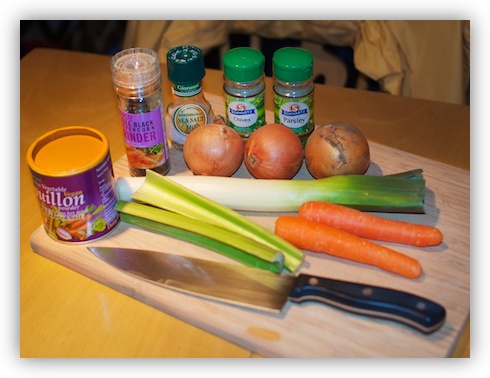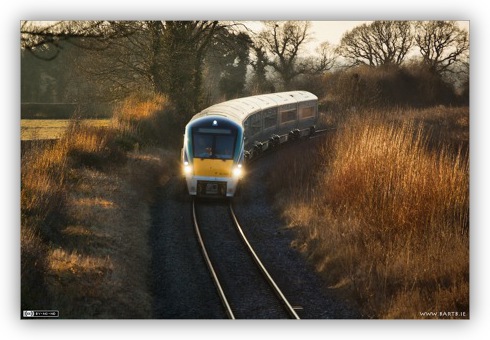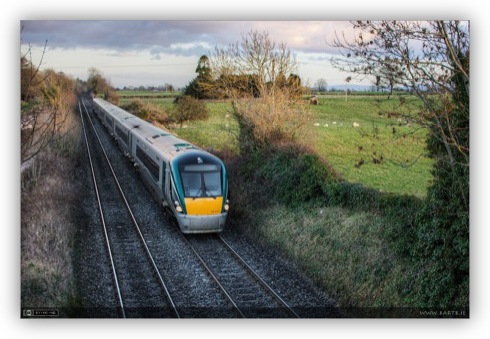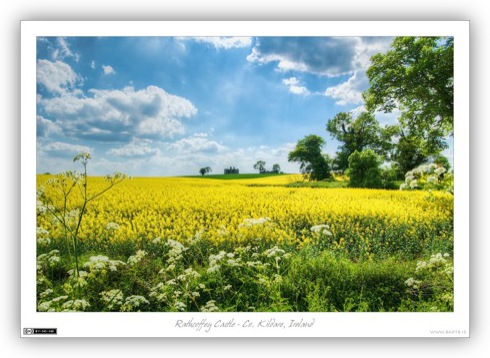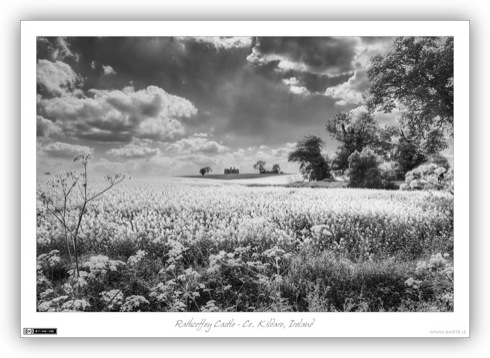Apr
26
Photo of the Week 166 & 167 – Irish Rail Class 22000
Filed Under Photography on April 26, 2011 | 2 Comments
I was bold again last weekend so this is yet another double post to get caught up again. The theme for this post is the new(ish) Irish Rail Class 22000 InterCity trainsets. These modern looking diesel multiple units have now replaced more traditional locomotive-hauled trains on the majority of Ireland’s InterCity routes. As well as being quite fast (rated to 100 miles an hour in Ireland), they also have plugs at every table, and are both quiet and comfortable. A nice modern addition to the Irish Rail fleet, at least from a passenger point of view. The die-hard train spotters all hate them for not being locomotives of course, but change always comes hard to fanatics. Personally, I love to travel on them and I think they look good and are very photogenic, so put me down as a fan 🙂
This first shot was taken on a beautiful summer evening and shows No.22043 rounding a corner at about 80mph as it approaches Maynooth with an InterCity service from Sligo to Dublin. The unit was quite new when this shot was taken, but already one of the covers for its couplers was missing.
- Camera: Nikon D40
- Lens: Nikon DX AFS 55-200mm
- Exposure: 1/640 sec
- Focal Length: 165mm
- Focal Ratio: f/5.3
- ISO: 400
- Camera Mode: Full Manual
- Processing: tonemapped lightly with Topaz Adjust, then tweaked a little using the built-in Dodge & Burn plugin in Aperture 2
The second shot is a more recent one, taken on a lovely spring evening this February, and shows the same trainset, this time approaching Pike Bridge with an InterCity service from Dublin to Sligo.
- Camera: Nikon D40
- Lens: Sigma EX 30mm f/1.4 DC HSM
- Exposure: 1/200 sec
- Focal Length: 30mm
- Focal Ratio: f/3.5
- ISO: 200
- Camera Mode: Full Manual
- Processing: created by tonemapping a single RAW image with Photomatix Pro, tweaking the result with the Topaz Adjust 4 plugin, and finally making a few small adjustments in Aperture 3
Apr
21
Where Does DropBox Store the Host ID on Mac OS X?
Filed Under System Administration, Security, Computers & Tech on April 21, 2011 | 4 Comments
The technosphere is a buzz this week with the news that DropBox’s security has a rather large and rather stupid hole in it. I’m only going to give a brief overview of the issue here, so if you’d like more details please check out the blog post that broke the story. What I do want to say is that this is a really infantile mistake on DropBox’s part, and the fact that they could overlook something so elementary for so long worries me a lot.
Anyhow – the whole problem revolves around the Host ID which DropBox uses to identify a computer within your account. This code acts as both an identifier and a password, and it’s a big long string of random looking gibberish. The problem is not that this ID is easy to guess, but rather that it’s not tied to any particular machine. If a bad-guy gets their hands on the file containing this ID they can effectively clone your machine in DropBox’s eyes, and see your files in perpetuity, regardless of how many times you change your password. The only way to kill the bad guy’s access would be to de-authorise the machine who’s ID they cloned in your account pages on the DropBox website.
The original blog post that broke this story describes in detail where you can find this ID on Windows, but doesn’t mention any other OSes. Quite a few listeners to my various podcasts have asked me if I know where the file is located on the Mac. I didn’t, but I figured it would be worth spending a little time finding the answer.
Apr
16
DOS Gaming on the Mac Made Easy
Filed Under Computers & Tech on April 16, 2011 | 5 Comments
 I grew up in the 80s, so I’ve always had a soft spot for the old DOS games I grew up with. I just loved the Apogee games, particularly Commander Keen and Secret Agent. We’ve been able to play these games on the Mac for years, but the experience has been a little too authentic. The free and open source DOSBox provides the basic emulation needed to run DOS games on modern PCs and Linux, as well as the Mac, but the experience is far from simple. You have to manually create a configuration file to even get started with DOSBox, and you need to know DOS to get your games installed and to run them. Not a problem for a terminal geek like me, but quite an obstacle for regular folks.
I grew up in the 80s, so I’ve always had a soft spot for the old DOS games I grew up with. I just loved the Apogee games, particularly Commander Keen and Secret Agent. We’ve been able to play these games on the Mac for years, but the experience has been a little too authentic. The free and open source DOSBox provides the basic emulation needed to run DOS games on modern PCs and Linux, as well as the Mac, but the experience is far from simple. You have to manually create a configuration file to even get started with DOSBox, and you need to know DOS to get your games installed and to run them. Not a problem for a terminal geek like me, but quite an obstacle for regular folks.
A few weeks ago my Grandfather asked me about running some of his old DOS games on his new Mac, so I looked into DOSBox again, and specifically went hunting for a nice GUI to simplify things. The first three I tried were horrifically poor. The worst kind of ‘by geeks, for geeks’ free software. Then I found Boxer, and I was just blown away. Boxer makes DOS games as easy to use as any other app on your Mac! The whole design of the project is just genius, and it’s been executed wonderfully. Attention to detail and usability are right at Boxer’s core.
Apr
12
Photo of the Week 164 & 165 – Summer in Rathcoffey
Filed Under Photography on April 12, 2011 | 3 Comments
It’s been a while since I missed a week, but I didn’t get around to posting a Photo of the Week the last two weekends, so this is a double-post to get caught up. As is my tradition with multiple posts, these are two related pictures – very related in fact, being two different renderings of the same picture!
The shot was taken on a fantastic summer day over-looking a field of Rape-seed flowers with an ancient ring fort in the left mid-ground, and the ruins of Rathcoffey Castle on the horizon.
The colour version was generated by tonemapping a single RAW image with Photomatix and Topaz Adjust, while the monocrhome version takes the colour version as it’s starting point before using the channel mixer in Aperture to convert it to a nice contrasty black and white shot.
- Camera: Nikon D40
- Lens: Nikon DX AFS 18-55mm (D40 kit lens)
- Exposure: 1/800 sec
- Focal Length: 18mm
- Focal Ratio: f/8
- ISO: 200
- Camera Mode: Aperture Priority
- Processing: created by tonemapping a single RAW image with Photomatix Pro, tweaking the result with the Topaz Adjust 4 plugin, and finally making a few small fixes with Aperture’s built-in Dodge & Burn plugin
- Camera: Nikon D40
- Lens: Nikon DX AFS 18-55mm (D40 kit lens)
- Exposure: 1/800 sec
- Focal Length: 18mm
- Focal Ratio: f/8
- ISO: 200
- Camera Mode: Aperture Priority
- Processing: created by tonemapping a single RAW image with Photomatix Pro, tweaking the result with the Topaz Adjust 4 plugin, and finally making a few small fixes with Aperture’s built-in Dodge & Burn plugin before using Aperture’s Channel Mixer brick to convert the image to monochrome
Apr
9
Traditional Belgian Vegetable Soup
Filed Under Cooking & Food on April 9, 2011 | 10 Comments
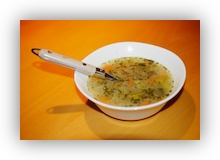 I think every Belgian mother and Grand Mother makes a version of this soup – all very similar, and yet all slightly different. This is my own take on it, which is a hybrid of my Mum’s version and her mother’s version.
I think every Belgian mother and Grand Mother makes a version of this soup – all very similar, and yet all slightly different. This is my own take on it, which is a hybrid of my Mum’s version and her mother’s version.
Lets start with a list of ingredients:
- Three medium-sized Onions
- Three medium-sized Potatoes (accidentally omitted from the photo below, sorry!)
- 2 medium-sized carrots
- 2 Sticks of Celery
- 1 big Leek
- 1 Litre of vegetable stock
- 1 to 2 Litres of water
- Parsley & Chives (preferably fresh, but dried is OK)
- Salt and Black Pepper
- Vegetable Oil
